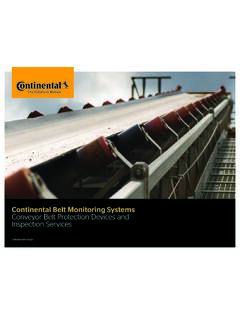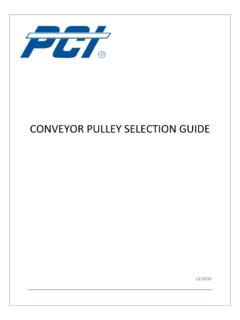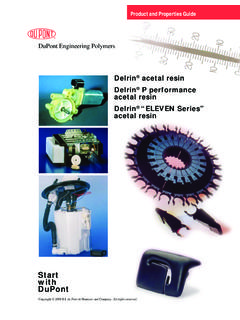Transcription of INTRODUCTION TO MACHINE VISION - Assembly Mag
1 INTRODUCTION TOMACHINE VISIONA guide to automating process & quality improvementsIntroduction to MACHINE VISION 2 What is MACHINE VISION ? ..3 Benefits of MACHINE VISION ..5 MACHINE VISION applications ..6 Guidance ..7 Identification ..8 Inspection ..10 Components of a MACHINE VISION system ..11 Back lighting ..13 Axial diffuse lighting ..13 Structured Directional lighting ..14 Dark-field illumination ..14 Bright-field Diffused dome lighting ..14 Strobe lighting ..14 Image sensor ..15 VISION processing ..16 Communications ..16 Different types of MACHINE VISION systems? ..17 1D VISION Systems ..17 2D Systems ..18 Area scan vs. line scan ..19 3D Systems ..20 MACHINE VISION platforms ..21 PC-based MACHINE VISION ..21 VISION controllers ..21 Standalone VISION VISION sensors and image-based barcode readers ..22 Conclusion ..23 TABLE OF CONTENTSI ntroduction to MACHINE VISION 3 WHAT IS MACHINE VISIONA ccording to the Automated Imaging Association (AIA), MACHINE VISION encompasses all industrial and non-industrial applications in which a combination of hardware and software provide operational guidance to devices in the execution of their functions based on the capture and processing of images.
2 Though industrial computer VISION uses many of the same algorithms and approaches as academic/educational and governmental/military applications of computer VISION , constraints are VISION systems demand greater robustness, reliability , and stability compared with an academic/educational VISION system and typically cost much less than those used in governmental/military applications. Therefore, industrial MACHINE VISION implies low cost, acceptable accuracy, high robustness, high reliability , and high mechanical, and temperature stability. MACHINE VISION systems rely on digital sensors protected inside industrial cameras with specialized optics to acquire images, so that computer hardware and software can process, analyze, and measure various characteristics for decision making. As an example, consider a fill-level inspection system at a brewery (Figure 1). Each bottle of beer passes through an inspection sensor, which triggers a VISION system to flash a strobe light and take a picture of the bottle.
3 After acquiring the image and storing it in memory, VISION software processes or analyzes it and issues a pass-fail response based on the fill level of the bottle. If the system detects an improperly filled bottle a fail it signals a diverter to reject the bottle. An operator can view rejected bottles and ongoing process statistics on a VISION systems can also perform objective measurements, such as determining a spark plug gap or providing location information that guides a robot to align parts in a manufacturing process. Figure 2 shows examples of how MACHINE VISION systems can be used to pass or fail oil filters (right) and measure the width of a center tab on a bracket (left). INTRODUCTION to MACHINE VISION 4 VISION System DisplayStrobeSensorGood oil filter (all holes are open)Reject oil filter (some holes are blocked) mmFigure 1. Bottle fill-level inspection exampleThe fill-level inspection system in this example permits only two possible responses, which characterizes it as a binary system: 1.
4 Pass if the product is good 2. Fail if the product is 2. MACHINE VISION systems can process real-time measurements and inspections on the production line, such as a machined bracket (left) or oil filters (right). INTRODUCTION to MACHINE VISION 5 BENEFITS OFMACHINE VISIONW here human VISION is best for qualitative interpretation of a complex, unstructured scene, MACHINE VISION excels at quantitative measurement of a structured scene because of its speed, accuracy, and repeatability. For example, on a production line, a MACHINE VISION system can inspect hundreds, or even thousands, of parts per minute. A MACHINE VISION system built around the right camera resolution and optics can easily inspect object details too small to be seen by the human eye. In removing physical contact between a test system and the parts being tested, MACHINE VISION prevents part damage and eliminates the maintenance time and costs associated with wear and tear on mechanical components.
5 MACHINE VISION brings additional safety and operational benefits by reducing human involvement in a manufacturing process. Moreover, it prevents human contamination of clean rooms and protects human workers from hazardous environments. MACHINE VISION helps meet strategic goalsMachine VISION helps meet strategic goalsStrategic GoalMachine VISION ApplicationsHigher qualityInspection, measurement, gauging, and Assembly verificationIncreased productivityRepetitive tasks formerly done manually are now done by MACHINE VISION SystemProduction flexibilityMeasurement and gauging / Robot guidance / Prior operation verificationLess MACHINE downtime and reduced setup timeChangeovers programmed in advanceMore complete information and tighter process controlManual tasks can now provide computer data feedbackLower capital equipment costsAdding VISION to a MACHINE improves its performance, avoids obsolescenceLower production costsOne VISION system vs. many people / Detection of flaws early in the processScrap rate reductionInspection, measurement, and gaugingInventory controlOptical Character Recognition and identificationReduced floorspaceVision system vs.
6 OperatorIntroduction to MACHINE VISION 6 MACHINE VISIONAPPLICATIONST ypically the first step in any MACHINE VISION application, whether the simplest Assembly verification or a complex 3D robotic bin-picking, is for pattern matching technology to find the object or feature of interest within the camera s field of view. Locating the object of interest often determines success or failure. If the pattern matching software tools can not precisely locate the part within the image, then it can not guide, identify, inspect, count, or measure the part. While finding a part sounds simple, differences in its appearance in actual production environments can make that step extremely challenging (Figure 3). Although VISION systems are trained to recognize parts based on patterns, even the most tightly controlled processes allow some variability in a part s appearance (Figure 4). To achieve accurate, reliable, and repeatable results, a VISION system s part location tools must include enough intelligence to quickly and accurately compare training patterns to the actual objects (pattern matching) moving down a production line.
7 Part location is the critical first step in the four major categories of MACHINE VISION applications. The categories are guidance, identification, gauging, and inspection, which can be remembered by the acronym (GIGI). Figure changes due to lighting or occlusion can make part location presentation or pose distortion effects can make part location DistortionRotatedNon LinearIntroduction to MACHINE VISION 7 GUIDANCE Guidance may be done for several reasons. First, MACHINE VISION systems can locate the position and orientation of a part, compare it to a specified tolerance, and ensure it s at the correct angle to verify proper Assembly . Next, guidance can be used to report the location and orientation of a part in 2D or 3D space to a robot or MACHINE controller, allowing the robot to locate the part or the MACHINE to align the part. MACHINE VISION guidance achieves far greater speed and accuracy than manual positioning in tasks such as arranging parts on or off pallets, packaging parts off a conveyor belt , finding and aligning parts for Assembly with other components, placing parts on a work shelf, or removing parts from bins.
8 Guidance can also be used for alignment to other MACHINE VISION tools. This is a very powerful feature of MACHINE VISION because parts may be presented to the camera in unknown orientations during production. By locating the part and then aligning the other MACHINE VISION tools to it, MACHINE VISION enables automatic tool fixturing. This involves locating key features on a part to enable precise positioning of caliper, blob, edge, or other VISION software tools so that they correctly interact with the part. This approach enables manufacturers to build multiple products on the same production line and reduces the need for expensive hard tooling to maintain part position during guidance requires geometric pattern matching. Pattern matching tools must tolerate large variations in contrast and lighting, as well as changes in scale, rotation, and other factors while finding the part reliably every time. This is because location information obtained by pattern matching enables the alignment of other MACHINE VISION software tools.
9 Figure 5a. Examples of images used in sauce packetsPrinted circuit board90 degree elbowIntroduction to MACHINE VISION 8 Figure 5b. Pattern matching can be A MACHINE VISION system for part identification and recognition reads barcodes (1-D), data matrix codes (2-D), direct part marks (DPM), and characters printed on parts, labels, and packages. An optical character recognition (OCR) system reads alphanumeric characters without prior knowledge, whereas an optical character verification (OCV) system confirms the presence of a character string. Additionally, MACHINE VISION systems can identify parts by locating a unique pattern or identify items based on color, shape, or size. DPM applications mark a code or character string directly on to the part. Manufacturers in all industries commonly use this technique for error-proofing, enabling efficient containment strategies, monitoring process control and quality-control metrics, and quantifying problematic areas in a plant such as bottlenecks.
10 Traceability by direct part marking improves asset tracking and part authenticity verification. It also provides unit-level data to drive superior technical support and warranty repair service by documenting the genealogy of the parts in a sub- Assembly that make up the finished PartOut of FocusScale Change/ Dim LightingConfusing Background180 RotationOcclusionReversed PolarityIntroduction to MACHINE VISION 9 Conventional barcodes have gained wide acceptance for retail checkout and inventory control. Traceability information, however, requires more data than can fit in a standard barcode. To increase the data capacity, companies developed 2-D codes, such as Data Matrix, which can store more information, including manufacturer, product identification, lot number, and even a unique serial number for virtually any finished good. GAUGING A MACHINE VISION system for gauging calculates the distances between two or more points or geometrical locations on an object and determines whether these measurements meet specifications.


